Junsheng Zhou
GAP: Gaussianize Any Point Clouds with Text Guidance
Aug 07, 2025Abstract:3D Gaussian Splatting (3DGS) has demonstrated its advantages in achieving fast and high-quality rendering. As point clouds serve as a widely-used and easily accessible form of 3D representation, bridging the gap between point clouds and Gaussians becomes increasingly important. Recent studies have explored how to convert the colored points into Gaussians, but directly generating Gaussians from colorless 3D point clouds remains an unsolved challenge. In this paper, we propose GAP, a novel approach that gaussianizes raw point clouds into high-fidelity 3D Gaussians with text guidance. Our key idea is to design a multi-view optimization framework that leverages a depth-aware image diffusion model to synthesize consistent appearances across different viewpoints. To ensure geometric accuracy, we introduce a surface-anchoring mechanism that effectively constrains Gaussians to lie on the surfaces of 3D shapes during optimization. Furthermore, GAP incorporates a diffuse-based inpainting strategy that specifically targets at completing hard-to-observe regions. We evaluate GAP on the Point-to-Gaussian generation task across varying complexity levels, from synthetic point clouds to challenging real-world scans, and even large-scale scenes. Project Page: https://weiqi-zhang.github.io/GAP.
iDiT-HOI: Inpainting-based Hand Object Interaction Reenactment via Video Diffusion Transformer
Jun 15, 2025Abstract:Digital human video generation is gaining traction in fields like education and e-commerce, driven by advancements in head-body animation and lip-syncing technologies. However, realistic Hand-Object Interaction (HOI) - the complex dynamics between human hands and objects - continues to pose challenges. Generating natural and believable HOI reenactments is difficult due to issues such as occlusion between hands and objects, variations in object shapes and orientations, and the necessity for precise physical interactions, and importantly, the ability to generalize to unseen humans and objects. This paper presents a novel framework iDiT-HOI that enables in-the-wild HOI reenactment generation. Specifically, we propose a unified inpainting-based token process method, called Inp-TPU, with a two-stage video diffusion transformer (DiT) model. The first stage generates a key frame by inserting the designated object into the hand region, providing a reference for subsequent frames. The second stage ensures temporal coherence and fluidity in hand-object interactions. The key contribution of our method is to reuse the pretrained model's context perception capabilities without introducing additional parameters, enabling strong generalization to unseen objects and scenarios, and our proposed paradigm naturally supports long video generation. Comprehensive evaluations demonstrate that our approach outperforms existing methods, particularly in challenging real-world scenes, offering enhanced realism and more seamless hand-object interactions.
DFEN: Dual Feature Equalization Network for Medical Image Segmentation
May 09, 2025Abstract:Current methods for medical image segmentation primarily focus on extracting contextual feature information from the perspective of the whole image. While these methods have shown effective performance, none of them take into account the fact that pixels at the boundary and regions with a low number of class pixels capture more contextual feature information from other classes, leading to misclassification of pixels by unequal contextual feature information. In this paper, we propose a dual feature equalization network based on the hybrid architecture of Swin Transformer and Convolutional Neural Network, aiming to augment the pixel feature representations by image-level equalization feature information and class-level equalization feature information. Firstly, the image-level feature equalization module is designed to equalize the contextual information of pixels within the image. Secondly, we aggregate regions of the same class to equalize the pixel feature representations of the corresponding class by class-level feature equalization module. Finally, the pixel feature representations are enhanced by learning weights for image-level equalization feature information and class-level equalization feature information. In addition, Swin Transformer is utilized as both the encoder and decoder, thereby bolstering the ability of the model to capture long-range dependencies and spatial correlations. We conducted extensive experiments on Breast Ultrasound Images (BUSI), International Skin Imaging Collaboration (ISIC2017), Automated Cardiac Diagnosis Challenge (ACDC) and PH$^2$ datasets. The experimental results demonstrate that our method have achieved state-of-the-art performance. Our code is publicly available at https://github.com/JianJianYin/DFEN.
Learning Bijective Surface Parameterization for Inferring Signed Distance Functions from Sparse Point Clouds with Grid Deformation
Mar 31, 2025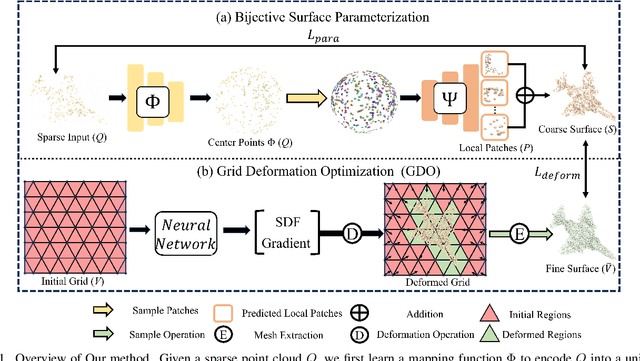
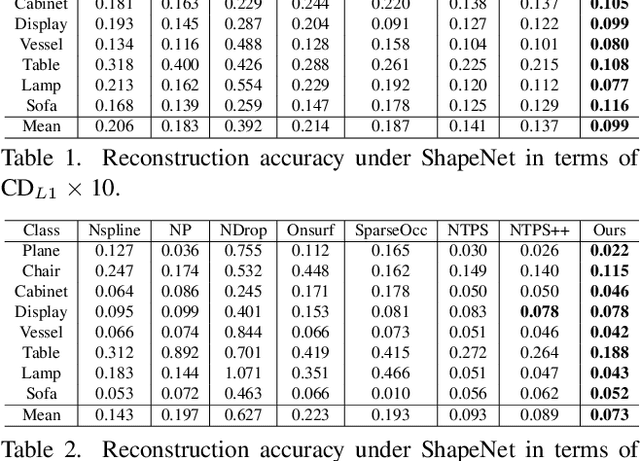
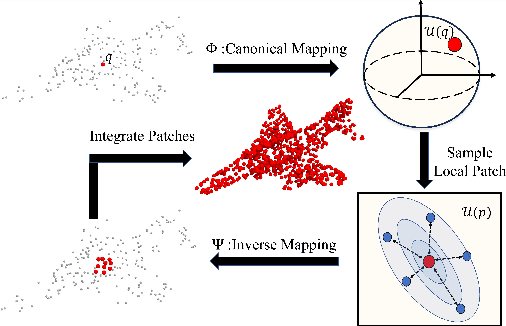
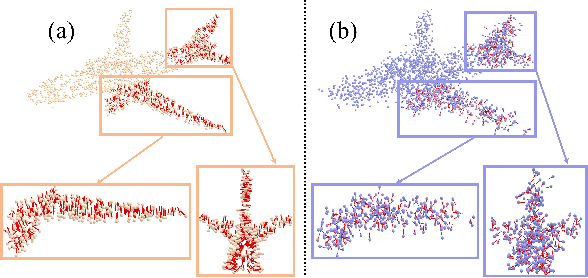
Abstract:Inferring signed distance functions (SDFs) from sparse point clouds remains a challenge in surface reconstruction. The key lies in the lack of detailed geometric information in sparse point clouds, which is essential for learning a continuous field. To resolve this issue, we present a novel approach that learns a dynamic deformation network to predict SDFs in an end-to-end manner. To parameterize a continuous surface from sparse points, we propose a bijective surface parameterization (BSP) that learns the global shape from local patches. Specifically, we construct a bijective mapping for sparse points from the parametric domain to 3D local patches, integrating patches into the global surface. Meanwhile, we introduce grid deformation optimization (GDO) into the surface approximation to optimize the deformation of grid points and further refine the parametric surfaces. Experimental results on synthetic and real scanned datasets demonstrate that our method significantly outperforms the current state-of-the-art methods. Project page: https://takeshie.github.io/Bijective-SDF
Uncertainty-Participation Context Consistency Learning for Semi-supervised Semantic Segmentation
Dec 24, 2024Abstract:Semi-supervised semantic segmentation has attracted considerable attention for its ability to mitigate the reliance on extensive labeled data. However, existing consistency regularization methods only utilize high certain pixels with prediction confidence surpassing a fixed threshold for training, failing to fully leverage the potential supervisory information within the network. Therefore, this paper proposes the Uncertainty-participation Context Consistency Learning (UCCL) method to explore richer supervisory signals. Specifically, we first design the semantic backpropagation update (SBU) strategy to fully exploit the knowledge from uncertain pixel regions, enabling the model to learn consistent pixel-level semantic information from those areas. Furthermore, we propose the class-aware knowledge regulation (CKR) module to facilitate the regulation of class-level semantic features across different augmented views, promoting consistent learning of class-level semantic information within the encoder. Experimental results on two public benchmarks demonstrate that our proposed method achieves state-of-the-art performance. Our code is available at https://github.com/YUKEKEJAN/UCCL.
DiffGS: Functional Gaussian Splatting Diffusion
Oct 25, 2024
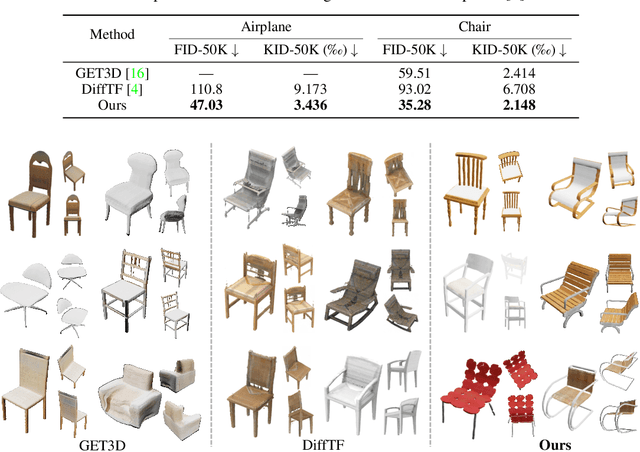
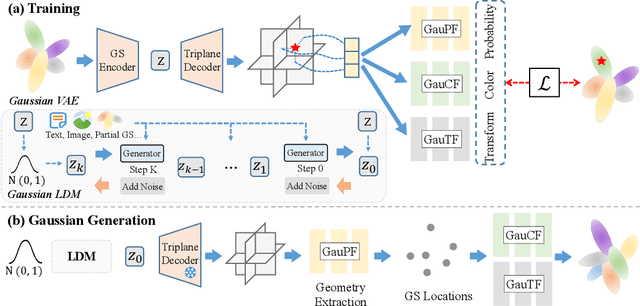
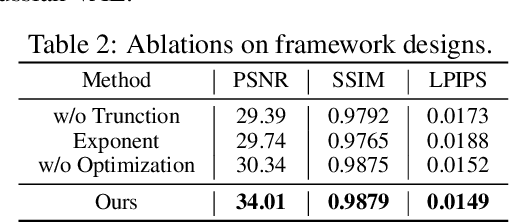
Abstract:3D Gaussian Splatting (3DGS) has shown convincing performance in rendering speed and fidelity, yet the generation of Gaussian Splatting remains a challenge due to its discreteness and unstructured nature. In this work, we propose DiffGS, a general Gaussian generator based on latent diffusion models. DiffGS is a powerful and efficient 3D generative model which is capable of generating Gaussian primitives at arbitrary numbers for high-fidelity rendering with rasterization. The key insight is to represent Gaussian Splatting in a disentangled manner via three novel functions to model Gaussian probabilities, colors and transforms. Through the novel disentanglement of 3DGS, we represent the discrete and unstructured 3DGS with continuous Gaussian Splatting functions, where we then train a latent diffusion model with the target of generating these Gaussian Splatting functions both unconditionally and conditionally. Meanwhile, we introduce a discretization algorithm to extract Gaussians at arbitrary numbers from the generated functions via octree-guided sampling and optimization. We explore DiffGS for various tasks, including unconditional generation, conditional generation from text, image, and partial 3DGS, as well as Point-to-Gaussian generation. We believe that DiffGS provides a new direction for flexibly modeling and generating Gaussian Splatting.
Binocular-Guided 3D Gaussian Splatting with View Consistency for Sparse View Synthesis
Oct 24, 2024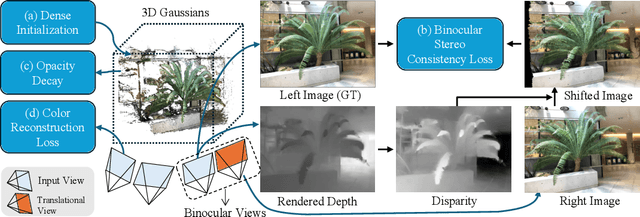
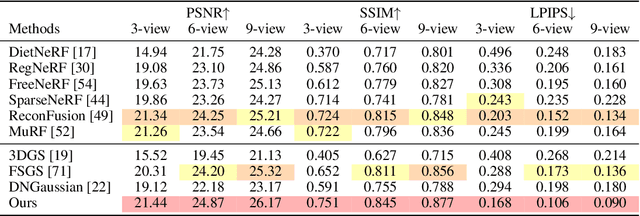
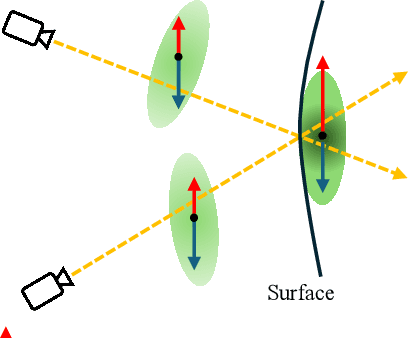
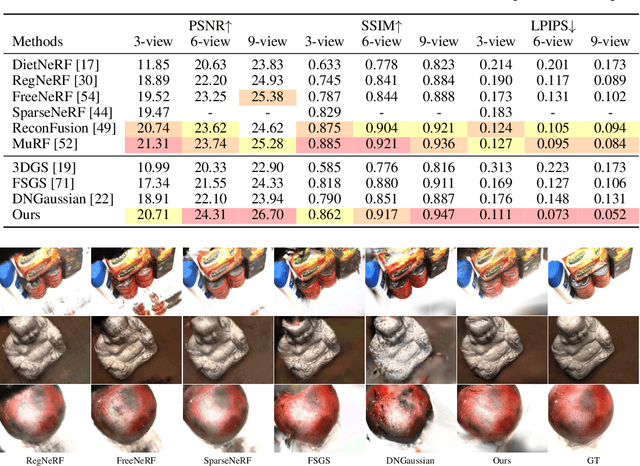
Abstract:Novel view synthesis from sparse inputs is a vital yet challenging task in 3D computer vision. Previous methods explore 3D Gaussian Splatting with neural priors (e.g. depth priors) as an additional supervision, demonstrating promising quality and efficiency compared to the NeRF based methods. However, the neural priors from 2D pretrained models are often noisy and blurry, which struggle to precisely guide the learning of radiance fields. In this paper, We propose a novel method for synthesizing novel views from sparse views with Gaussian Splatting that does not require external prior as supervision. Our key idea lies in exploring the self-supervisions inherent in the binocular stereo consistency between each pair of binocular images constructed with disparity-guided image warping. To this end, we additionally introduce a Gaussian opacity constraint which regularizes the Gaussian locations and avoids Gaussian redundancy for improving the robustness and efficiency of inferring 3D Gaussians from sparse views. Extensive experiments on the LLFF, DTU, and Blender datasets demonstrate that our method significantly outperforms the state-of-the-art methods.
Zero-Shot Scene Reconstruction from Single Images with Deep Prior Assembly
Oct 21, 2024Abstract:Large language and vision models have been leading a revolution in visual computing. By greatly scaling up sizes of data and model parameters, the large models learn deep priors which lead to remarkable performance in various tasks. In this work, we present deep prior assembly, a novel framework that assembles diverse deep priors from large models for scene reconstruction from single images in a zero-shot manner. We show that this challenging task can be done without extra knowledge but just simply generalizing one deep prior in one sub-task. To this end, we introduce novel methods related to poses, scales, and occlusion parsing which are keys to enable deep priors to work together in a robust way. Deep prior assembly does not require any 3D or 2D data-driven training in the task and demonstrates superior performance in generalizing priors to open-world scenes. We conduct evaluations on various datasets, and report analysis, numerical and visual comparisons with the latest methods to show our superiority. Project page: https://junshengzhou.github.io/DeepPriorAssembly.
UDiFF: Generating Conditional Unsigned Distance Fields with Optimal Wavelet Diffusion
Apr 10, 2024Abstract:Diffusion models have shown remarkable results for image generation, editing and inpainting. Recent works explore diffusion models for 3D shape generation with neural implicit functions, i.e., signed distance function and occupancy function. However, they are limited to shapes with closed surfaces, which prevents them from generating diverse 3D real-world contents containing open surfaces. In this work, we present UDiFF, a 3D diffusion model for unsigned distance fields (UDFs) which is capable to generate textured 3D shapes with open surfaces from text conditions or unconditionally. Our key idea is to generate UDFs in spatial-frequency domain with an optimal wavelet transformation, which produces a compact representation space for UDF generation. Specifically, instead of selecting an appropriate wavelet transformation which requires expensive manual efforts and still leads to large information loss, we propose a data-driven approach to learn the optimal wavelet transformation for UDFs. We evaluate UDiFF to show our advantages by numerical and visual comparisons with the latest methods on widely used benchmarks. Page: https://weiqi-zhang.github.io/UDiFF.
Learning Continuous Implicit Field with Local Distance Indicator for Arbitrary-Scale Point Cloud Upsampling
Dec 23, 2023Abstract:Point cloud upsampling aims to generate dense and uniformly distributed point sets from a sparse point cloud, which plays a critical role in 3D computer vision. Previous methods typically split a sparse point cloud into several local patches, upsample patch points, and merge all upsampled patches. However, these methods often produce holes, outliers or nonuniformity due to the splitting and merging process which does not maintain consistency among local patches. To address these issues, we propose a novel approach that learns an unsigned distance field guided by local priors for point cloud upsampling. Specifically, we train a local distance indicator (LDI) that predicts the unsigned distance from a query point to a local implicit surface. Utilizing the learned LDI, we learn an unsigned distance field to represent the sparse point cloud with patch consistency. At inference time, we randomly sample queries around the sparse point cloud, and project these query points onto the zero-level set of the learned implicit field to generate a dense point cloud. We justify that the implicit field is naturally continuous, which inherently enables the application of arbitrary-scale upsampling without necessarily retraining for various scales. We conduct comprehensive experiments on both synthetic data and real scans, and report state-of-the-art results under widely used benchmarks.
 Add to Chrome
Add to Chrome Add to Firefox
Add to Firefox Add to Edge
Add to Edge